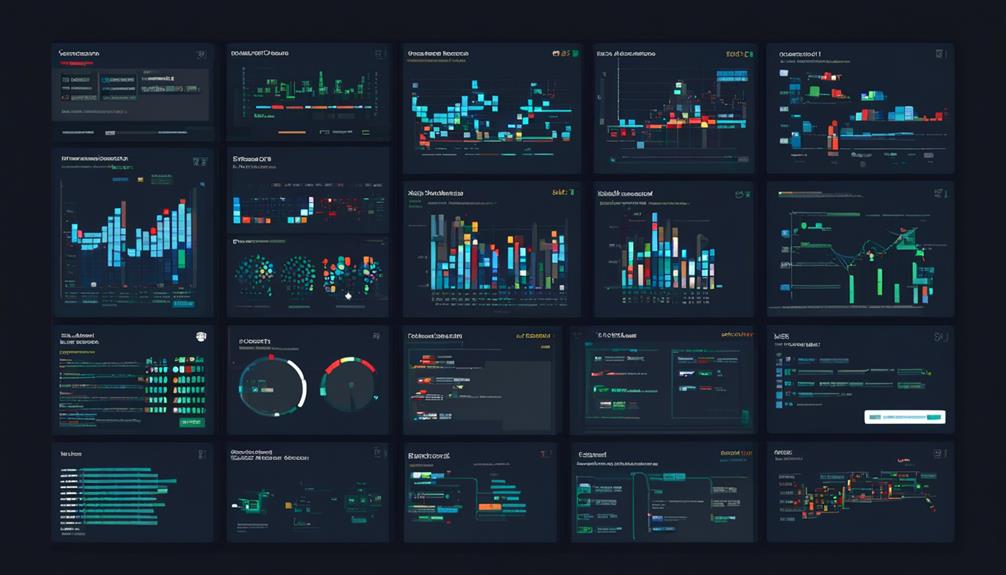In today's ever-evolving threat landscape, organizations are facing increasing challenges in protecting their networks and data from sophisticated cyber attacks.
Next-Generation Firewalls (NGFWs) have emerged as a vital security solution, offering a range of advanced features that go beyond the capabilities of traditional firewalls.
From enhanced performance and scalability to advanced threat detection and prevention, NGFWs provide a comprehensive defense against even the most cunning attackers.
Moreover, with features like application visibility and control, user and group-based policies, and real-time threat intelligence, NGFWs empower organizations to gain greater control over their network traffic and respond swiftly to emerging threats.
In this discussion, we will explore the key NGFW features and their significance in safeguarding network infrastructure, ensuring data confidentiality, and preserving business continuity.
Key Takeaways
- NGFWs provide high-performance decryption and deep packet inspection capabilities, ensuring robust security at the network edge and internal boundaries.
- Advanced threat detection and prevention features, such as real-time threat analysis and behavioral anomaly detection, enable proactive defense against sophisticated cyber attacks.
- Real-time threat analysis and behavioral anomaly detection continuously monitor network traffic and behavior, utilizing machine learning and AI algorithms for pattern analysis and immediate response to evolving threats.
- SSL/TLS inspection enhances security posture by decrypting and inspecting encrypted traffic, uncovering hidden malware threats and preventing data exfiltration, while optimizing NGFW settings and hardware resources ensures both security and network performance during inspection.
NGFW Performance and Scalability

NGFW performance and scalability are crucial factors to consider when selecting a next-generation firewall for handling increasing data volume and network complexity. As organizations generate and transmit larger amounts of data and face more advanced threats, NGFWs need to offer high-performance decryption and deep packet inspection capabilities. These features enable NGFWs to inspect encrypted traffic and provide robust security at the network edge and internal boundaries.
To ensure effective protection, NGFWs incorporate various features such as intrusion prevention systems (IPS), advanced malware detection, and application control. By combining these capabilities, NGFWs deliver greater control and better security than traditional firewalls. Stateful inspection of network traffic is a key feature that allows NGFWs to monitor the state of connections and make informed decisions about allowing or blocking traffic.
In addition to the security features, NGFWs should also possess scalability to accommodate growing data volumes and network complexities. As the demand for bandwidth increases, NGFWs must be capable of handling higher traffic loads without compromising performance. This scalability is vital to prevent bottlenecks and ensure a smooth flow of network traffic.
It is worth mentioning that many NGFWs function in isolation and lack cross-platform integration. This limitation can hinder the ability to secure networks against sophisticated threats. Therefore, organizations should consider NGFWs that offer seamless integration with other security products and platforms, enabling unified threat management and stronger defense against evolving threats.
Advanced Threat Detection and Prevention
Advanced threat detection and prevention in NGFW involves real-time threat analysis and behavioral anomaly detection.
Real-time threat analysis allows for the immediate identification and mitigation of potential threats.
Behavioral anomaly detection helps detect abnormal activities that may indicate the presence of advanced threats.
These capabilities enhance the NGFW's ability to proactively defend against sophisticated cyber attacks and provide a higher level of security for network environments.
Real-Time Threat Analysis
Real-time threat analysis is a crucial component of network security, providing advanced detection and prevention capabilities to identify and stop sophisticated cyber threats as they occur. With the ever-increasing complexity of cyber attacks, next-generation firewalls (NGFW) must have robust features to ensure effective protection.
Here are the key capabilities of real-time threat analysis:
- Continuous monitoring: Real-time threat analysis continuously monitors network traffic and behavior, enabling the detection of anomalies and potential threats in real-time.
- Machine learning and AI algorithms: By utilizing machine learning and AI algorithms, NGFW can analyze patterns, detect new threats, and respond rapidly to emerging risks.
- Proactive protection: Real-time threat analysis offers proactive protection by identifying and blocking zero-day attacks and unknown malware in real-time.
- Immediate response: NGFW enhances security posture by providing immediate response and mitigation against evolving threats without manual intervention.
- Advanced threat detection: Real-time threat analysis enables the identification and prevention of advanced threats, ensuring the security of the network.
These features make real-time threat analysis a critical component of next-generation firewalls, safeguarding networks against advanced cyber threats.
Behavioral Anomaly Detection
Behavioral Anomaly Detection in network security is a powerful feature that identifies abnormal network behavior indicative of advanced threats. This advanced security capability is incorporated into Next-Generation Firewall (NGFW) solutions to enhance threat detection and prevention capabilities in the ever-evolving threat landscape. By utilizing machine learning and AI, Behavioral Anomaly Detection establishes a baseline of normal network behavior and alerts on deviations, thereby detecting previously unknown attack patterns. This proactive defense mechanism enables NGFWs to detect and stop sophisticated attacks in real-time, providing organizations with improved security posture. To illustrate the significance of Behavioral Anomaly Detection, consider the following table:
| Traditional Security Measures | Behavioral Anomaly Detection | |
|---|---|---|
| Detection Accuracy | Moderate | High |
| Identifying Unknown Attacks | Limited | Advanced |
| Real-Time Protection | Limited | Effective |
Application Visibility and Control

The NGFW's Application Visibility and Control feature enables precise identification and classification of applications on the network, allowing for effective enforcement of security and productivity policies. With this feature, organizations can gain better control over the applications being used within their network, ensuring that only authorized and safe applications are allowed while blocking or limiting the usage of potentially harmful or unproductive ones.
Here are five key benefits of the NGFW's Application Visibility and Control:
- Enhanced network security: By accurately identifying and classifying applications, the NGFW can enforce security policies tailored to specific applications. This helps in preventing unauthorized access, data breaches, and the spread of advanced malware.
- Improved productivity: The NGFW can enforce productivity policies by controlling the usage of non-business-related applications. It allows organizations to prioritize critical applications, allocate network resources accordingly, and ensure optimal performance for essential tasks.
- Detailed insights: Application Visibility and Control provide organizations with detailed visibility into application usage patterns. This information helps in optimizing network performance, identifying potential security risks, and making informed decisions about resource allocation.
- Detection of evasive applications: NGFWs equipped with Application Visibility and Control can detect and block evasive or unknown applications, even if they are disguised as legitimate traffic. This capability is essential for preventing potential security threats and protecting the network from emerging risks.
- Enhanced firewall capabilities: By integrating Application Visibility and Control into their firewall capabilities, organizations can have a more comprehensive and robust security posture. It allows for more granular control over network traffic and enables the NGFW to adapt to changing application landscapes.
Intrusion Prevention System (IPS)
As we shift our focus to the subtopic of Intrusion Prevention System (IPS), an essential feature integrated into NGFW, we explore its role in monitoring network traffic for malicious activity and providing proactive defense against known and zero-day attacks.
The integration of IPS into NGFW enhances network security by adding an additional layer of protection against advanced threats.
IPS within NGFW employs various techniques to detect and prevent unauthorized access and potential exploits. It monitors network traffic in real-time, analyzing packets and inspecting the content to identify any signs of malicious activity. This includes the use of signatures, policies, and anomaly detection to block potential threats. By actively monitoring network traffic, IPS enables NGFW to identify and block traffic associated with known attack patterns, ensuring timely response and mitigation.
One of the key advantages of IPS within NGFW is its application awareness. It can identify and control specific applications within the network, enabling granular control over the traffic. This allows organizations to define policies and enforce restrictions based on the application being used, further strengthening security posture.
Furthermore, IPS plays a crucial role in defending against zero-day attacks. It utilizes advanced threat intelligence and behavior-based analysis to detect and block previously unknown threats. This proactive approach helps to mitigate the risks posed by rapidly evolving attack techniques.
SSL/TLS Inspection

SSL/TLS Inspection is a crucial feature of NGFW that allows for the decryption and inspection of encrypted traffic, thereby uncovering hidden malware threats.
However, implementing SSL/TLS Inspection may have performance implications due to the additional processing required for decrypting and inspecting encrypted traffic.
To ensure the effective implementation of SSL/TLS Inspection, it is important to follow best practices that address issues such as certificate management, trust validation, and privacy concerns.
Benefits of SSL/TLS Inspection
SSL/TLS Inspection is a crucial feature that allows for the decryption and inspection of encrypted traffic, ensuring robust security against hidden threats. By incorporating SSL/TLS Inspection into a firewall, organizations can enhance their security posture by gaining visibility into encrypted traffic and identifying and blocking threats that may be concealed within encrypted sessions.
The benefits of SSL/TLS Inspection include:
- Detection of malware and malicious content within encrypted communication.
- Prevention of data exfiltration and exploitation of encrypted communication channels by cyber attackers.
- Security policy enforcement and threat detection for all traffic, including encrypted traffic.
- Enhanced visibility into encrypted traffic, providing valuable insights for security teams.
- Advanced inspection capabilities that enable the identification and blocking of hidden threats.
Performance Impact Analysis
The evaluation of the performance impact caused by decrypting and inspecting encrypted traffic on NGFW is a critical aspect of SSL/TLS Inspection. Performance Impact Analysis assesses the effect of SSL/TLS decryption on various factors including CPU and memory usage, latency, and throughput. By analyzing these impacts, organizations can determine the NGFW's capacity to handle SSL/TLS traffic while maintaining both security and network performance. The analysis helps identify potential trade-offs between security and performance, enabling organizations to optimize NGFW settings and hardware resources to minimize performance degradation during SSL/TLS inspection. To provide a clearer overview, the following table summarizes the factors evaluated in Performance Impact Analysis:
| Factors | Description |
|---|---|
| CPU usage | Evaluation of NGFW's CPU utilization |
| Memory usage | Assessment of NGFW's memory consumption |
| Latency | Measurement of delays in traffic inspection |
| Throughput | Analysis of NGFW's ability to process traffic |
Best Practices for Implementation
To successfully implement SSL/TLS inspection while considering privacy and compliance concerns, organizations should adhere to best practices that ensure transparent communication with users and efficient network performance.
Here are some key best practices for implementing SSL/TLS inspection with a Next-Generation Firewall (NGFW):
- Establish a clear SSL/TLS inspection policy: Define the scope and purpose of inspection, and communicate this policy to users to maintain transparency and trust.
- Proper certificate management: Ensure that the NGFW has the necessary certificates to decrypt and inspect SSL/TLS traffic without compromising security.
- Optimize network performance: Implement hardware acceleration and utilize NGFW features, such as session resumption and connection caching, to minimize the impact of SSL/TLS inspection on network performance.
- User education: Educate users about SSL/TLS inspection, its benefits, and the measures in place to safeguard their privacy, addressing any concerns they may have.
- Regular policy review: Periodically review and update SSL/TLS inspection policies and practices to adapt to evolving security threats and compliance requirements.
User and Group-based Policies

User and group-based policies in NGFW provide administrators with granular control over access and permissions, allowing for tailored security measures based on individual or group requirements. These policies enable administrators to define specific rules and restrictions for different users or groups within the network, enhancing security by ensuring that access to applications and resources is based on user identity and group membership.
By leveraging these policies, organizations can enforce tailored security measures, such as restricting access to sensitive data for certain user groups. For example, an organization may want to limit access to confidential financial information to only authorized members of the finance department. With user and group-based policies, the NGFW can enforce these restrictions, preventing unauthorized users from accessing sensitive data.
User and group-based policies also help organizations maintain a balance between security and productivity. By customizing network access based on individual or group requirements, organizations can ensure that employees have the appropriate level of access to perform their job duties, while also protecting sensitive information from unauthorized access. For example, a marketing team may require access to social media platforms for their job responsibilities, while other departments do not. User and group-based policies allow the NGFW to grant or restrict access accordingly, improving productivity while maintaining security.
Cloud Integration and Security
Cloud integration and security is a crucial aspect of next-generation firewalls (NGFWs), offering enhanced protection and control over network traffic. NGFWs can be deployed on-premise, in a public or private cloud environment, providing protection at the network edge and internal boundaries. They have the capability to inspect encrypted traffic, ensuring enhanced security and scalability for internal private networks.
To further enhance security, NGFWs can also be deployed as cloud services, known as Firewall as a Service (FWaaS). This allows for improved security for remote locations and cloud infrastructure. By integrating with cloud platforms, NGFWs offer better visibility and control over network traffic. This enables the implementation of granular access controls and protection against advanced threats.
Cloud integration in NGFWs also allows for the integration of threat intelligence feeds. These feeds provide real-time information about emerging threats, enabling NGFWs to proactively defend against malicious activities. By leveraging threat intelligence feeds, NGFWs can block known malicious IP addresses, domains, and URLs, preventing them from accessing the network.
Additionally, NGFWs, such as Cloudflare Magic Firewall, are tightly integrated with Secure Access Service Edge (SASE) platforms. This integration ensures network-level security and protection for users and office networks. SASE platforms combine network security with wide-area networking capabilities, providing a comprehensive solution for organizations.
Centralized Management and Reporting

Centralized Management and Reporting is a key feature of next-generation firewalls (NGFWs), providing a unified interface for configuring and monitoring multiple devices. This feature allows for the centralized configuration and monitoring of NGFW devices from a single interface, simplifying network security management. It offers a unified view of network traffic and security events across all NGFW devices, providing comprehensive visibility.
With Centralized Management and Reporting, administrators can enforce consistent security policies and updates across the entire network. This ensures that all devices are configured with the same security settings, reducing the risk of any vulnerabilities or inconsistencies. Additionally, this feature streamlines administrative tasks by providing a single point of control for all NGFW devices.
Another significant advantage of Centralized Management and Reporting is the generation of comprehensive reports and analytics. Administrators can obtain detailed information on network traffic, security incidents, and policy enforcement. These reports provide enhanced visibility into the network, helping to identify any potential security threats or compliance issues.
Real-time Threat Intelligence
As network security management becomes increasingly complex, real-time threat intelligence emerges as a crucial component for next-generation firewalls (NGFWs). Real-time threat intelligence in NGFW provides immediate updates and information about emerging threats, allowing organizations to stay one step ahead of cybercriminals.
Here are five key benefits of incorporating real-time threat intelligence into NGFW:
- Dynamic security policy adjustment: NGFW leverages real-time threat intelligence to dynamically adjust security policies and block potential threats. By analyzing incoming traffic in real-time, NGFW can identify and respond to malicious activities, preventing them from infiltrating the network.
- Detection and blocking of new threats: With real-time threat intelligence, NGFW can identify and block new and evolving threats as soon as they are detected. This capability is crucial in the ever-changing landscape of cybersecurity, where new malware and attack techniques are constantly emerging.
- Protection against zero-day attacks: NGFW's real-time threat intelligence enhances its ability to detect and respond to zero-day attacks, which are exploits targeting vulnerabilities that are unknown to the software vendor. By constantly updating its threat intelligence database, NGFW can detect and block zero-day attacks before they can cause significant damage.
- Defense against advanced persistent threats (APTs): APTs are sophisticated attacks that aim to breach a network and remain undetected for an extended period. Real-time threat intelligence provides NGFW with the necessary information to identify and mitigate APTs, ensuring that the network remains secure.
- Continuous updates and protection: Real-time threat intelligence in NGFW ensures that the firewall is continuously updated with the latest threat information. This proactive approach to security ensures that the organization is protected against the latest malware and emerging threats.
Frequently Asked Questions
What Are the Features of Next-Generation Firewall?
Next-Generation Firewalls (NGFWs) offer a wide range of advanced features that differentiate them from traditional firewalls. These include:
- Advanced threat protection
- Deep packet inspection
- Application control and visibility
- Scalability and performance
NGFWs provide enhanced security by combining stateful inspection with application awareness and control, enabling the blocking of risky apps. They also offer integrated intrusion prevention and advanced malware detection capabilities, enforcing network segmentation for zero-trust security.
Furthermore, NGFWs support encrypted traffic inspection, enabling the detection of hidden malware.
Which Two Features Are Available Only in Next-Generation Firewalls?
Two features that are available only in next-generation firewalls (NGFW) are advanced threat protection and user and application control.
Advanced threat protection refers to the ability of NGFWs to detect and prevent advanced threats such as zero-day exploits and targeted attacks.
User and application control allows NGFWs to identify and control application traffic based on user identity and specific application characteristics.
These features, along with other NGFW capabilities like intrusion prevention system, SSL/TLS inspection, and malware detection and prevention, make NGFWs essential for modern network security.
What Is the Function of Ngfw?
The function of a Next-Generation Firewall (NGFW) is to provide advanced security measures by inspecting and controlling network traffic at the application layer. Its primary role is to apply security policies and rules to all traffic passing through it, ensuring protection against various cyber threats.
NGFW's benefits lie in its ability to incorporate features such as intrusion prevention, antimalware, and sandboxing, which collectively enhance network visibility and enable effective threat detection and mitigation.
Its importance as a first line of defense against modern cyberattacks cannot be understated, making it an indispensable tool in today's digital landscape.
What Are the Three Key Differentiators of Ngfw?
The three key differentiators of NGFW are its enhanced application and user control capabilities, robust security features, and in-depth network traffic visibility.
NGFWs provide granular control over applications and users, enabling organizations to enforce security policies effectively. They incorporate features like IPS, antimalware, and sandboxing to provide comprehensive security against advanced threats.
Additionally, NGFWs offer deep visibility into network traffic, allowing for early detection and prevention of potential threats.
These differentiators make NGFWs a valuable tool for organizations seeking advanced network security solutions.
